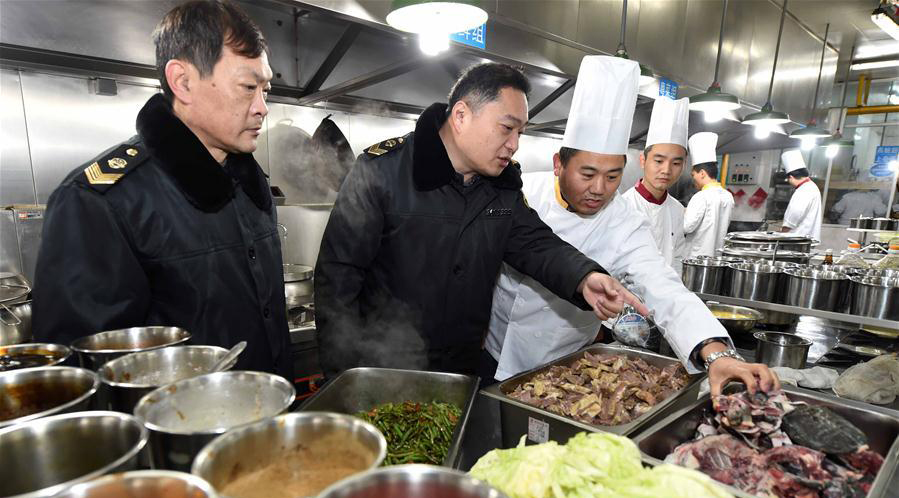Social mechanism, technology to ensure food safety in China

Law enforcement officials from the Market Supervision and Administration Department under Yaohai District of Hefei, Anhui Province check ingredients in a restaurant kitchen on Jan. 17.
China’s main agricultural products and market supply remains stable while its quality supervision system continued to improve and effectively safeguarded public food safety, according to the 2015 Report on Food Safety in China released at the end of 2016.
Wu Linhai, chief expert of Jiangsu Provincial Research Base of Food Safety under Jiangnan University, said that China is currently suffering from problems of food safety, but we cannot deny that the overall situation is steadily improving.
It is impossible to eradicate food safety risks entirely, but the current problems can be attributed to a variety of factors, said Yin Shijiu, a professor from Shandong Provincial Strategy Research Centre of Food Safety Governance under Qufu Normal University.
The factors affecting food safety include social and economic development status, scientific and technological advancement, as well as production environment and living conditions.
In terms of origins, Wu divided the factors into two categories, which are human factors and natural factors, including irresistible technology change. These two categories constitute the sources of risks and incidents regarding food safety that the whole world faces, Wu emphasized.
Carried out by large numbers of family farmers, agricultural production is scattered and diverse in form, Yin said. Pesticide residue and other remnants of chemicals as well as land pollution are risks threatening food safety. Also, producers lack a sense of responsibility. Man-made risks require tougher supervision, Yin said.
In China, the overall stable situation of food safety stands in contrast with low public satisfaction. Controversy also exists because people pay close attention to food safety while lacking relevant knowledge, said Sun Baoguo, an academician of the Chinese Academy of Engineering and president of Beijing Technology and Business University. Public communication, public lectures and technological innovations can help to solve the problems, Sun added.
A better governance pattern of food safety requires four guidelines: the strictest standards, the toughest supervision, the sternest punishment and the most severe accountability, Yin said.
The government has limited resources, however. A joint governance pattern that involves enterprises, social organizations and individuals is more effective and efficient because it clarifies the subjects of governance, who have common interests, Wu said.
Yin suggested optimizing and unifying the authorities for food safety supervision based on an orientation toward public safety. Efforts should be made to establish departments respectively focusing on executive supervision, enforcement and technologies at all levels. Institutions should amend and draft unified, justified supervisory laws and regulations as well as safety standards. Also, local departments need to play a leading role in administrative enforcement regarding food safety.
Requirements of technical governance should be turned into national basic norms to control food safety risks. The ability to govern food safety risks can be promoted through compulsory standards, relevant laws and regulations, Wu said.
Health is the crucial development goal for the Chinese and global food industry, Sun said. To tackle China’s food safety issue, technology is the backbone of producing healthier, nutritious food while upgrading the ability to monitor the field, thus promoting China’s overall food safety, he added.

 PRINT
PRINT CLOSE
CLOSE